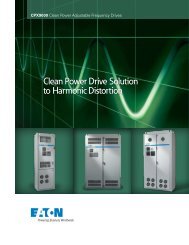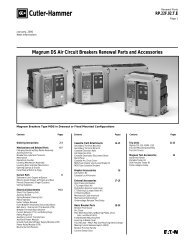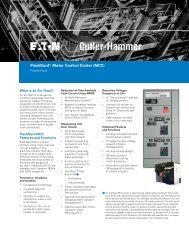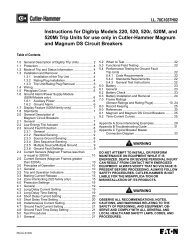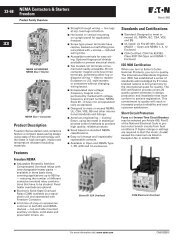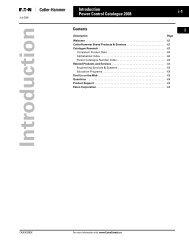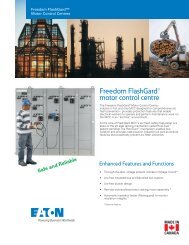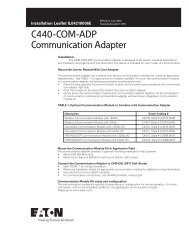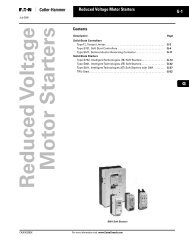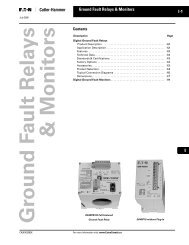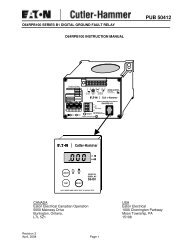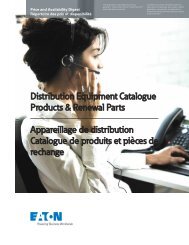M-Maxâ„¢ Series Adjustable Frequency Drive - Eaton Corporation
M-Maxâ„¢ Series Adjustable Frequency Drive - Eaton Corporation
M-Maxâ„¢ Series Adjustable Frequency Drive - Eaton Corporation
Create successful ePaper yourself
Turn your PDF publications into a flip-book with our unique Google optimized e-Paper software.
Engineering<br />
The leakage current to ground is greater than 3.5 mA with a<br />
frequency inverter. Based on the requirements of EN 50178,<br />
an increased ground (PE) has to be connected. The cable<br />
cross-section must be at least 10 mm2<br />
or consist of two<br />
separately connected ground cables.<br />
Residual current circuit breakers must be suitable for:<br />
●<br />
●<br />
●<br />
the protection of installations with DC current component<br />
in case of fault scenario (RCD type B)<br />
high leakage currents (300 mA)<br />
brief discharges of pulse current spikes<br />
Input Contactor<br />
The input contactor enables an operational switching on and<br />
off of the supply voltage for the frequency inverter, and<br />
switching off in case of a fault.<br />
The input contactor is designed based on the input current<br />
(ILN ) of the frequency inverter and the utilization category<br />
AC-1 (IEC 60947). Input contactors and the assignment to<br />
M-Max frequency inverters are explained in the appendix.<br />
While planning the project, make sure that inching operation<br />
is not done via the input contactor of the frequency inverter<br />
on frequency-controlled drives, but through a controller input<br />
of the frequency inverter.<br />
The maximum permitted operating frequency of the input<br />
voltage with the M-Max frequency inverter is one time per<br />
minute (normal operation).<br />
EMC Measures<br />
Electrical components in a system (machine) have a<br />
reciprocal effect on each other. Each device not only emits<br />
interference but is also affected by it. The interference can<br />
be produced by galvanic, capacitive, and/or inductive<br />
sources, or by electromagnetic radiation. In practice, the limit<br />
between line-conducted interference and emitted<br />
interference is around 30 MHz. Above 30 MHz, cables and<br />
conductors act like antennas that radiate electromagnetic<br />
waves.<br />
EMC Environment and Category<br />
Measuring<br />
Point<br />
Category C1<br />
Public<br />
Low-Voltage<br />
Supply Grid<br />
Public Medium-Voltage Supply Grid<br />
Industry<br />
Grid 1<br />
22 M-Max <strong>Series</strong> <strong>Adjustable</strong> <strong>Frequency</strong> <strong>Drive</strong><br />
Industry<br />
Grid 2<br />
Category C1/C2 Category C3/C4 Category C3/C4<br />
1 st Enviroment 2 nd Enviroment<br />
Electromagnetic compatibility (EMC) for frequency controlled<br />
drives (variable speed drives) is implemented in accordance<br />
with product standard IEC/EN 61800-3. This includes the<br />
complete power drive system (PDS), from the input supply to<br />
the motor, including all components, as well as cables (see<br />
figure on Page 18).<br />
This type of drive system can consist of<br />
several individual drives.<br />
The generic standards of the individual components in a PDS<br />
compliant with IEC/EN 61800-3 do not apply. These<br />
component manufacturers, however, must offer solutions<br />
that ensure standards-compliant use.<br />
In Europe, maintaining the EMC guidelines is mandatory.<br />
A declaration of conformity (CE) always refers to a “typical”<br />
power drive system (PDS). The responsibility to comply with<br />
the legally stipulated limit values and thus the provision of<br />
electromagnetic compatibility is ultimately the responsibility<br />
of the end user or system operator. This operator must also<br />
take measures to minimize or remove emission in the<br />
environment concerned (see figure below). He must also use<br />
means to increase the interference immunity of the devices<br />
of the system.<br />
With their high interference immunity up to category C3,<br />
M-Max frequency inverters are ideal for use in harsh<br />
industrial networks (2nd environment).<br />
With line-conducted emission, type MMX…-F_ frequency<br />
inverters (with integrated interference suppression filter)<br />
ensure the observance of the sensitive limit values of<br />
category C2 in environment 1. This requires an<br />
EMC-compliant installation (see Page 31)<br />
and the<br />
observance of the permissible motor cable lengths and<br />
maximum switching frequency (fPWM ) of the inverter.<br />
Type MMX…-N_ frequency inverters can comply with the<br />
limit values of category C1 in environment 1 when used in<br />
conjunction with an assigned external interference<br />
suppression filter.<br />
The required EMC measures should be taken into account in<br />
the engineering phase. Improvements and modifications<br />
during mounting and installation or even at the installation<br />
site involve additional and even considerably higher costs.<br />
MN04020003E—April 2011 www.eaton.com



